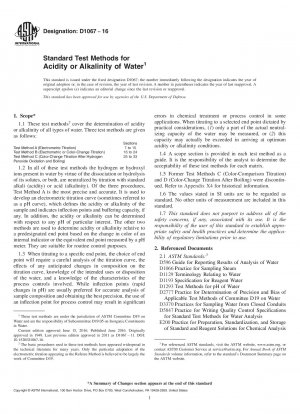ASTM D1067-16
Standard Test Methods for Acidity or Alkalinity of Water
- Standard No.
- ASTM D1067-16
- Release Date
- 2016
- Published By
- American Society for Testing and Materials (ASTM)
- Latest
- ASTM D1067-16
- Scope
4.1 Acidity and alkalinity measurements are used to assist in establishing levels of chemical treatment to control scale, corrosion, and other adverse chemical equilibria.
4.2 Levels of acidity or alkalinity are critical in establishing solubilities of some metals, toxicity of some metals, and the buffering capacity of some waters.
1.1 These test methods2 cover the determination of acidity or alkalinity of all types of water. Three test methods are given as follows:
Sections
Test Method A (Electrometric Titration)
7 to 15
Test Method B (Electrometric or Color-Change Titration)
16 to 24
Test Method C (Color-Change Titration After Hydrogen
Peroxide Oxidation and Boiling)25 to 33
1.2 In all of these test methods the hydrogen or hydroxyl ions present in water by virtue of the dissociation or hydrolysis of its solutes, or both, are neutralized by titration with standard alkali (acidity) or acid (alkalinity). Of the three procedures, Test Method A is the most precise and accurate. It is used to develop an electrometric titration curve (sometimes referred to as a pH curve), which defines the acidity or alkalinity of the sample and indicates inflection points and buffering capacity, if any. In addition, the acidity or alkalinity can be determined with respect to any pH of particular interest. The other two methods are used to determine acidity or alkalinity relative to a predesignated end point based on the change in color of an internal indicator or the equivalent end point measured by a pH meter. They are suitable for routine control purposes.
1.3 When titrating to a specific end point, the choice of end point will require a careful analysis of the titration curve, the effects of any anticipated changes in composition on the titration curve, knowledge of the intended uses or disposition of the water, and a knowledge of the characteristics of the process controls involved. While inflection points (rapid changes in pH) are usually preferred for accurate analysis of sample composition and obtaining the best precision, the use of an inflection point fo......
ASTM D1067-16 Referenced Document
- ASTM D1066 Standard Practice for Sampling Steam
- ASTM D1129 Standard Terminology Relating to Water
- ASTM D1193 Standard Specification for Reagent Water
- ASTM D1293 Standard Test Methods for pH of Water
- ASTM D2777 Standard Practice for Determination of Precision and Bias of Applicable Methods of Committee D-19 on Water
- ASTM D3370 Standard Practices for Sampling Water from Closed Conduits
- ASTM D5847 Standard Practice for Writing Quality Control Specifications for Standard Test Methods for Water Analysis
- ASTM D596 Standard Guide for Reporting Results of Analysis of Water
- ASTM E200 Standard Practice for Preparation, Standardization, and Storage of Standard and Reagent Solutions for Chemical Analysis
ASTM D1067-16 history
- 2016 ASTM D1067-16 Standard Test Methods for Acidity or Alkalinity of Water
- 2011 ASTM D1067-11 Standard Test Methods for Acidity or Alkalinity of Water
- 2006 ASTM D1067-06 Standard Test Methods for Acidity or Alkalinity of Water
- 2002 ASTM D1067-02 Standard Test Methods for Acidity or Alkalinity of Water
- 1992 ASTM D1067-92(1996) Standard Test Methods for Acidity or Alkalinity of Water
- 1988 ASTM D1067-88 Standard Test Methods for Acidity or Alkalinity of Water

Copyright ©2024 All Rights Reserved